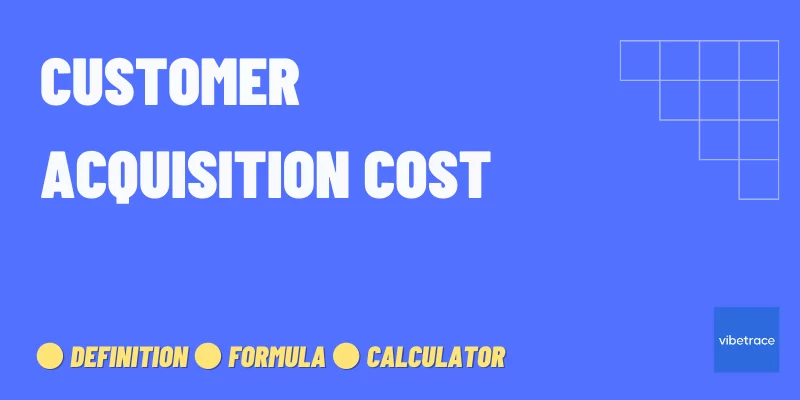Customer Acquisition Cost (CAC) measures the health of your sales, marketing, and customer service programs.
There could be tons of ideas about improving your marekting strategies but you must be able to analyze how well your efforts are doing.
This is the reason why CAC must be monitored by your business. It is the cost of trying to persuade a customers to check out your product and buy them.
So how well do you think does your marketing works for you?
What is Customer Acquisition Cost?
Definition of Customer Acquisition Cost
Customer Acquisition Cost (CAC) is the amount of money a business spends on marketing and sales activities to acquire a new customer.
It is a critical metric that helps businesses evaluate the effectiveness and efficiency of their marketing campaigns and sales efforts.
It’s essential for businesses to monitor their CAC because if it costs more to acquire a customer than the revenue they generate, the business will eventually lose money.
By analyzing and optimizing CAC, you can adjust your business marketing and sales strategies to attract customers more efficiently and cost-effectively.
Customer Acquisition Cost Formula
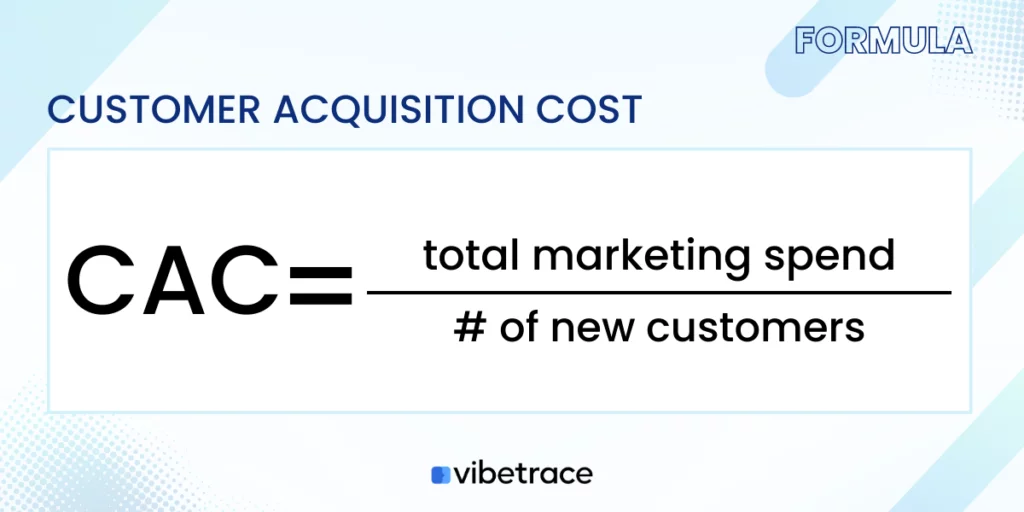
To calculate CAC, you need to sum up all the costs associated with your sales and marketing activities, including salaries, advertising, events, software tools, and any other expenses related to acquiring new customers.
Then, divide this total cost by the number of new customers acquired during the same period.
For example, if a business spent $50,000 on sales and marketing in a month and acquired 1,000 new customers, the CAC would be $50.
Customer Acquisition Cost by Industry
The following shows the Average Organic CAC and Average Inorganic CAC by Industry:
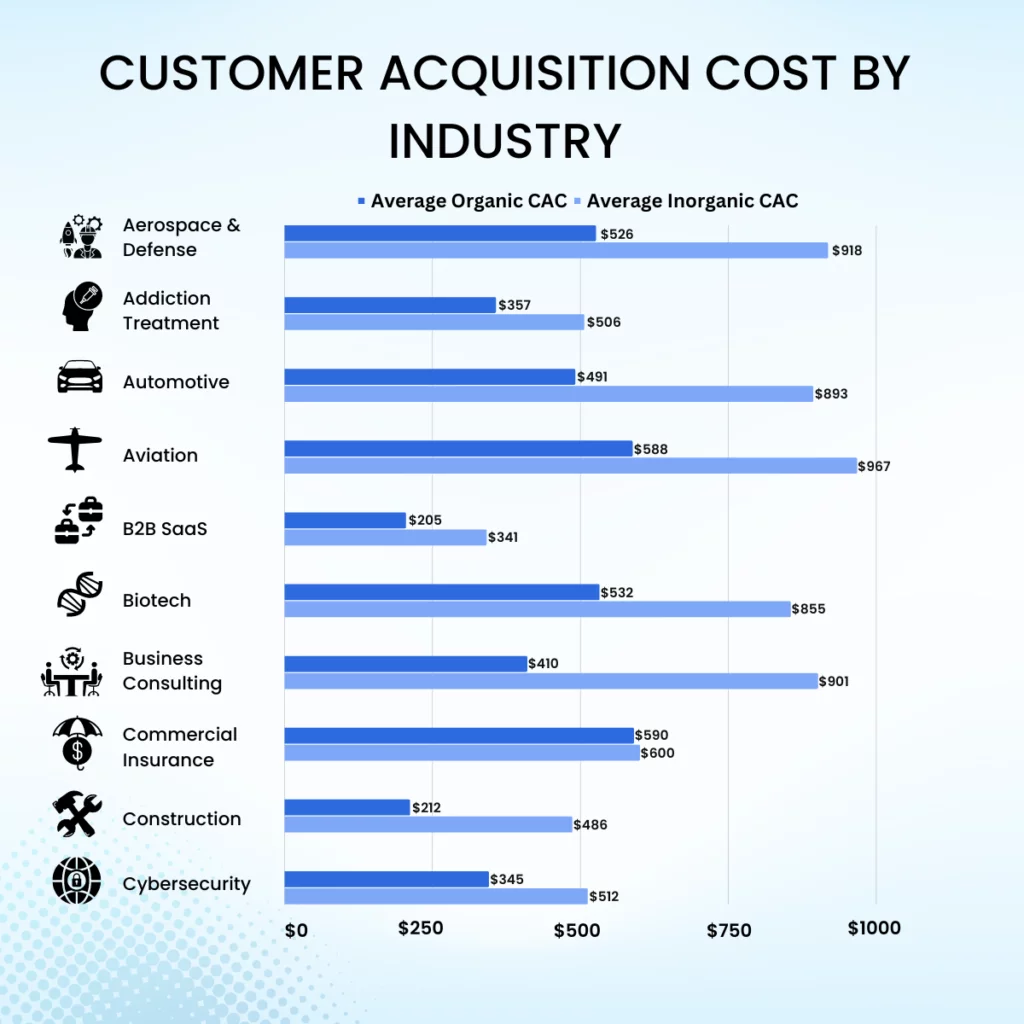
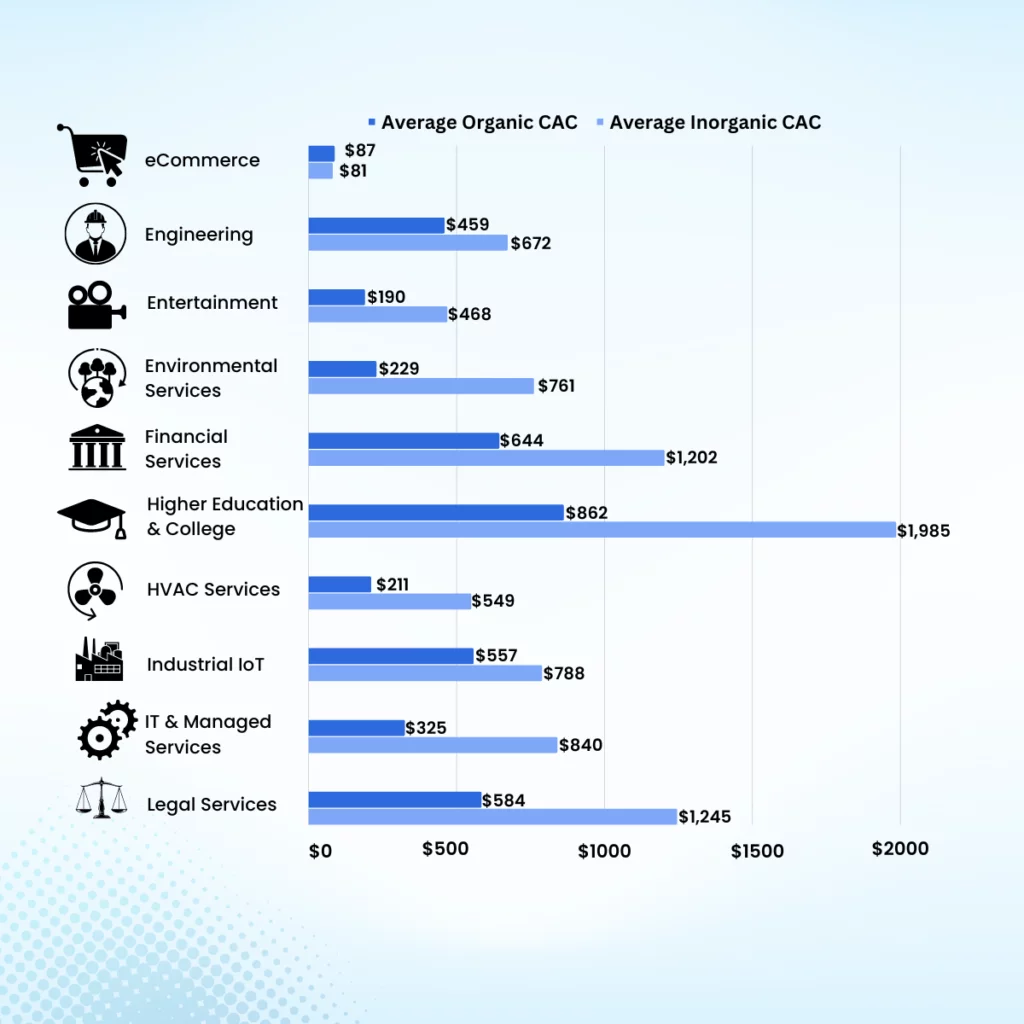
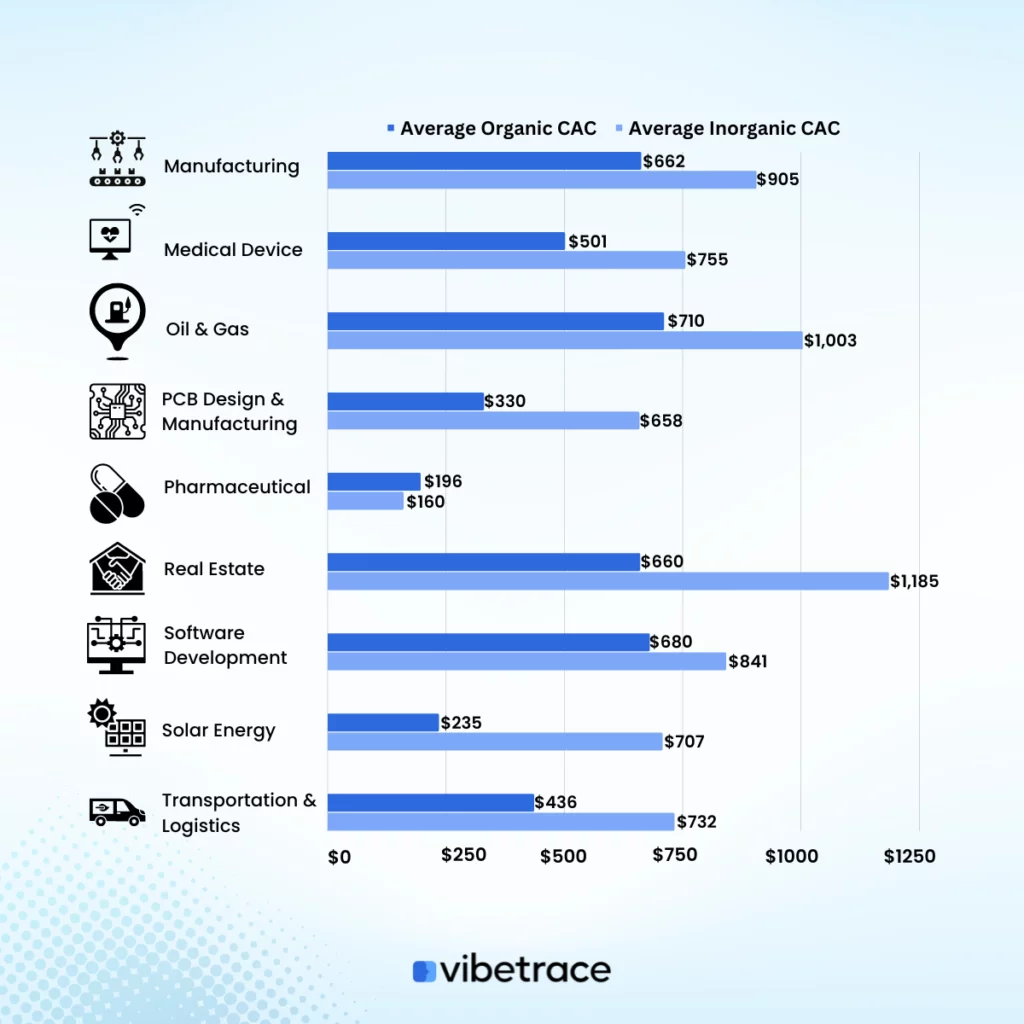
| Industry | Average Organic CAC | Average Inorganic CAC |
| Aerospace & Defense | $526 | $918 |
| Addiction Treatment | $357 | $506 |
| Automotive | $491 | $893 |
| Aviation | $588 | $967 |
| B2B SaaS | $205 | $341 |
| Biotech | $532 | $855 |
| Business Consulting | $410 | $901 |
| Commercial Insurance | $590 | $600 |
| Construction | $212 | $486 |
| Cybersecurity | $345 | $512 |
| eCommerce | $87 | $81 |
| Engineering | $459 | $672 |
| Entertainment | $190 | $468 |
| Environmental Services | $229 | $761 |
| Financial Services | $644 | $1,202 |
| Higher Education & College | $862 | $1,985 |
| HVAC Services | $211 | $549 |
| Industrial IoT | $557 | $788 |
| IT & Managed Services | $325 | $840 |
| Legal Services | $584 | $1,245 |
| Manufacturing | $662 | $905 |
| Medical Device | $501 | $755 |
| Oil & Gas | $710 | $1,003 |
| PCB Design & Manufacturing | $330 | $658 |
| Pharmaceutical | $196 | $160 |
| Real Estate | $660 | $1,185 |
| Software Development | $680 | $841 |
| Solar Energy | $235 | $707 |
| Transportation & Logistics | $436 | $732 |
The data provided shows the Average Customer Acquisition Cost (CAC) by industry for the B2B (business-to-business) sector according to FirstPageSage.
Want to be up to date with Marketing?
Subscribe to our Retail CX newsletter!

Stay connected with what’s really important to optimize your digital revenues.
By clicking the button, you accept our Terms & Conditions. Also you will need to confirm your email address.
Customer Acquisition Cost is the amount of money a company spends on acquiring a new customer, which includes all the expenses involved in the marketing, advertising, and sales efforts that lead to a customer’s purchase.
The data is presented in a table format with two columns – Average Organic CAC and Average Inorganic CAC.
The Average Organic CAC is the cost of acquiring a new customer through organic marketing efforts, such as search engine optimization (SEO) or content marketing.
The Average Inorganic CAC is the cost of acquiring a new customer through paid marketing efforts, such as advertising or pay-per-click (PPC) campaigns.
The table includes a list of 29 industries, ranging from Aerospace & Defense to Transportation & Logistics. For each industry, the table provides the Average Organic CAC and Average Inorganic CAC.
Looking at the data, you can observe that the average CAC varies significantly between different industries.
For instance, the highest average CAC is observed in the Higher Education & College industry with an average inorganic CAC of $1,985. On the other hand, the lowest average CAC is in the eCommerce industry with an average organic CAC of $87.
Overall, the data on Average Customer Acquisition Cost (CAC) By Industry: B2B Edition can be helpful for most businesses to understand the costs involved in acquiring new customers in the industry and to plan their marketing and advertising strategies accordingly.
How to track Customer Acquisition Cost?
Tracking your company’s CAC can help you understand if you are investing the right money in exchange of gaining more new customers.
Additionally, it is best to keep a look at it to improve your overall marketing performance in reaching out to potential customers.
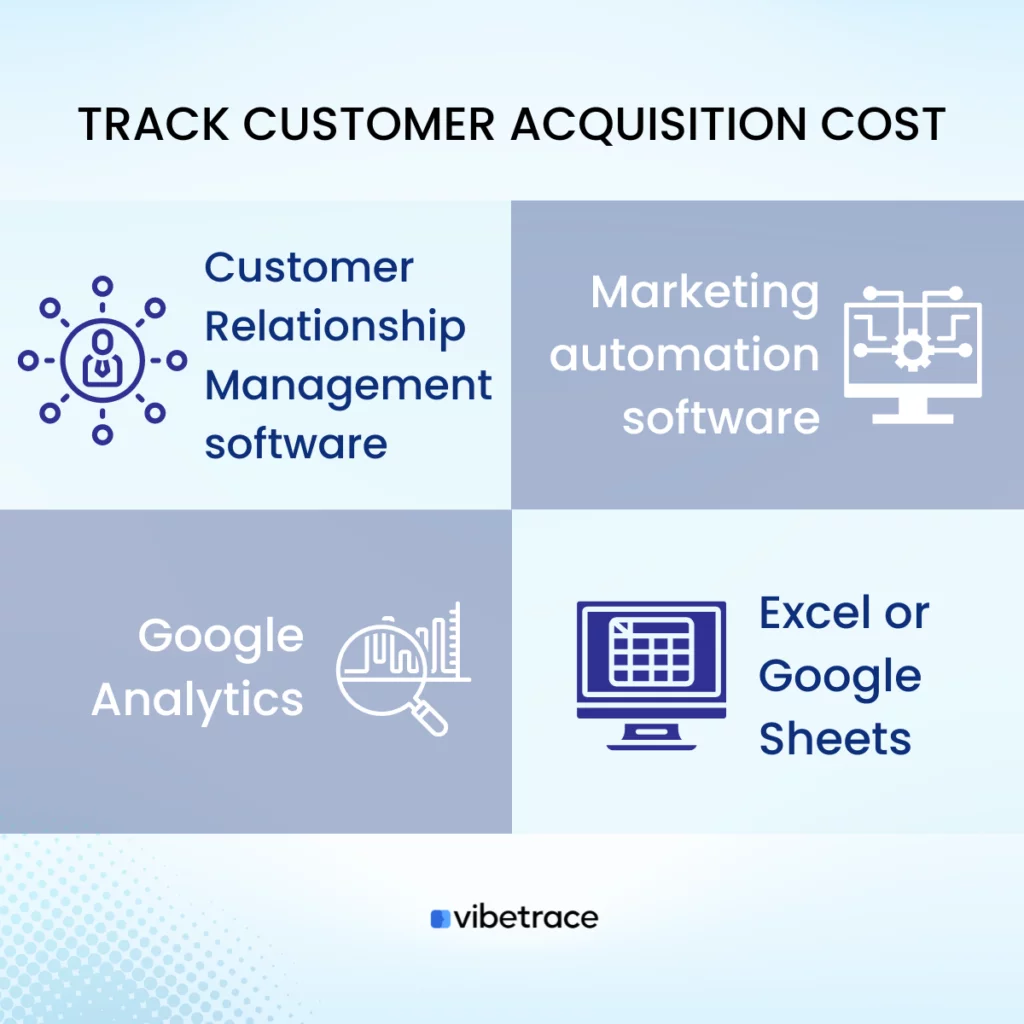
There are several tools that businesses can use to track and analyze their Customer Acquisition Cost (CAC). Here are some examples:
CRM software: CRM software like Salesforce, HubSpot, or Zoho CRM may assist you in tracking leads and prospects and calculating CAC based on the marketing and sales activity connected with each customer.
Google Analytics: Google Analytics is a free online analytics tool that may give useful information about website traffic and conversions. It can assist you in tracking the sources of your website visitors and determining which marketing channels are most effective in driving conversions.
Marketing automation software: Marketo, Eloqua, and Pardot are examples of marketing automation technologies that may help you automate your marketing campaigns, monitor leads, and assess the ROI of your marketing efforts, including CAC.
Excel or Google Sheets: You may also track marketing and sales expenditures and compute CAC using spreadsheet tools such as Excel or Google Sheets.
By using these tools, you can more easily track and optimize your CAC, which can help you make more informed decisions and improve your business’s overall marketing and sales performance.
How often should you check Customer Acquisition Cost?
In general, it’s a good idea to monitor your CAC regularly, especially when you are in the early stages of your business or making significant changes to your marketing strategies. This will help you identify trends and make data-driven decisions about how to optimize your marketing spend.
For most businesses, a monthly or quarterly review of CAC can provide valuable insights into the effectiveness of marketing efforts.
However, if you are running an e-commerce business or another fast-paced business that involves frequent customer interactions, you may need to check your CAC more frequently, such as weekly or even daily.
Ultimately, the key is to find the right balance between being vigilant about your CAC and avoiding getting bogged down by too much data analysis.
Customer Acquisition Cost Calculator
Do you want to calculate your customer acquisition cost? Use our simple calculator below.
Simple Customer Acquisition Cost Calculator
Important Things about Customer Acquisition Cost
Customer Acquisition Cost (CAC) is an essential metric for businesses, particularly those that rely on marketing and sales to generate revenue. Here are some important things to know about CAC:
The total cost of acquiring a new customer: CAC includes all of the costs associated with attracting, nurturing, and converting a lead into a paying customer, such as advertising, events, software tools, and sales salaries.
Varies by industry, business model, and customer type: Different industries and business models have different CAC benchmarks, and CAC can vary depending on the target customer type, geographic location, and product or service offering.
Required to be monitored regularly: CAC should be monitored on a regular basis to identify trends, patterns, and potential issues that may impact the effectiveness of the marketing and sales efforts.
Compared to Lifetime Value (LTV): To determine if the cost of acquiring a customer is worth the revenue that the customer is likely to generate, businesses should compare CAC to LTV.
Reducing CAC is not always the goal: While reducing CAC can improve profitability, it’s not always the most important goal. For example, if a business is in a growth phase and needs to acquire more customers to achieve scale, it may be willing to spend more to acquire each customer.
CAC can be reduced by optimizing the sales and marketing funnel: By optimizing the sales and marketing funnel, businesses can reduce CAC by improving conversion rates, reducing customer churn, and generating more leads more cost-effectively.
Overall, understanding and monitoring CAC is critical to a business’s success, as it can help improve the efficiency and effectiveness of the customer acquisition process and increase profitability.
Metrics related to Customer Acquisition Cost
There are several metrics related to Customer Acquisition Cost (CAC) that your business should monitor and analyze to gain a better understanding of the effectiveness of your marketing and sales efforts. Here are a few key metrics related to CAC:
Customer Lifetime Value
The estimated total value of a customer to a business over the course of their lifetime
Return on Marketing Investment
The return on investment in a marketing or advertising campaign
Payback Period
The amount of time it takes for a business to recoup the cost of acquiring a new customer.
Churn Rate
The percentage of customers who stop using a product or service over a given time period.
Vibetrace is a marketing automation platform that can help improve the customer acquisition cost (CAC) of your business by using personalized and automated campaigns to attract and retain customers.
It allows you to create targeted and personalized campaigns that are tailored to the specific needs and interests of your customers. This ensures that you are only targeting potential customers who are more likely to convert, reducing your CAC.
Sign up for our email list today and learn more about what we can do for your business!

